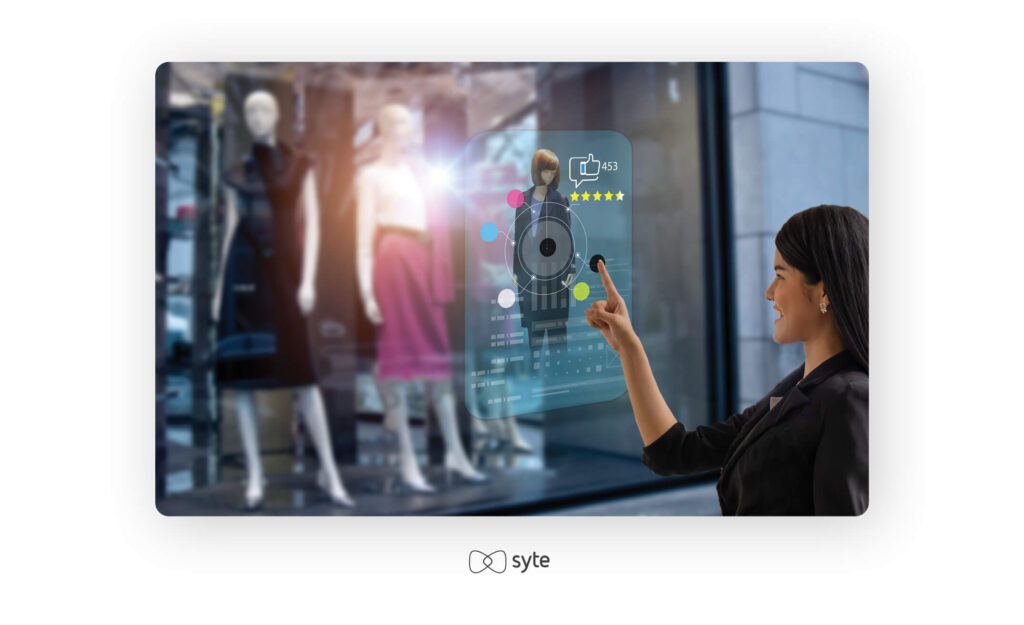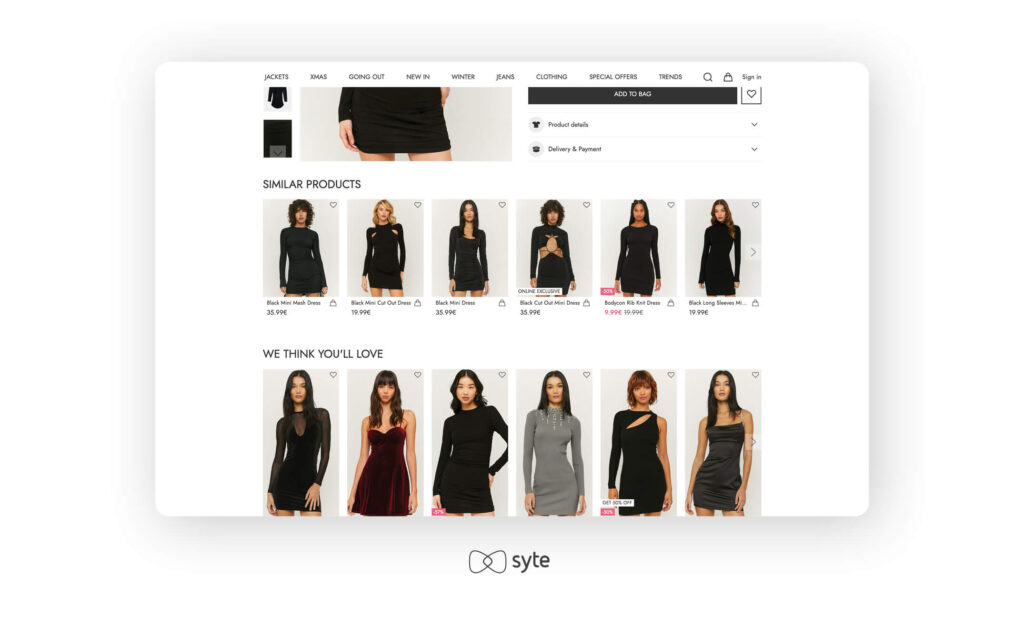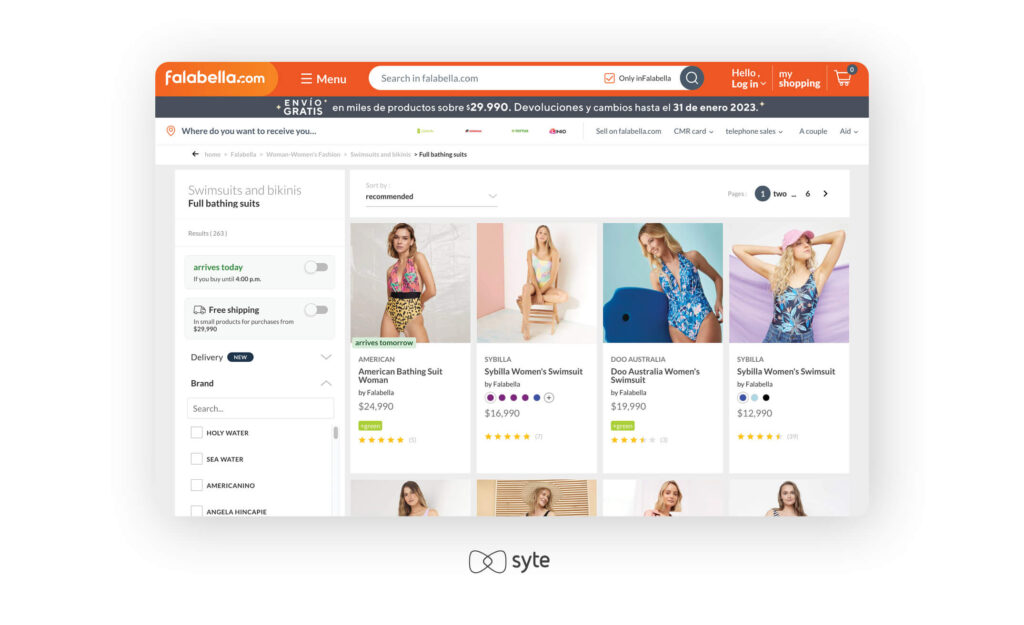Steady annual growth is on the horizon for fashion eCommerce. Already accounting for about 23% of total online retail sales in the US, eCommerce is expected to generate $300 billion in sales by 2025. While the numbers are optimistic, many brands and retailers are struggling to keep up with disruptions – from global supply chain shortcomings to rising inflation.
With stiff competition, providing memorable customer experiences is more important than ever. Visual AI-powered deep tagging ensures high accuracy and relevance when it comes to product discovery, which provides fashion companies with a much-needed edge.
The Rise of Global Fashion eCommerce
Fashion makes up a significant portion of global eCommerce revenue. In 2021, the market was valued at $700 billion and is expected to continue climbing, reaching over $1.2 trillion by 2025. Shoppers spend the most on luxury apparel with every visit, followed by active apparel, general apparel, and footwear.
To edge out the competition, brands are increasingly investing in technology to engage digital natives. According to McKinsey & Co., fashion companies invested between 1.6% and 1.8% of their revenues in technology, and the figure is expected to rise to 3% and 3.5% by 2030. Fashion companies already using artificial intelligence (AI) could see a 118% increase in cash flow by 2030, while other verticals could see a 23% decline.
With inflation in major markets and a looming global recession impacting how customers spend their money, digital investments in personalization, operations management, and store technologies are all steps in the right direction.

What Is Deep Tagging?
Deep tagging is a technology powered by visual AI that automatically and accurately assigns attributes to SKUs and organizes a retailer’s inventory. With deep learning, neural networks, image recognition, and advanced algorithms, the technology analyzes a photo to generate metadata based on visual attributes and creates links among relevant keywords. It’s the foundation of multiple website functions, such as textual and visual search, filters, and product recommendation engines.
Robust AI clothing tags can connect shoppers to highly relevant products. These tags learn from user behavior, paving the way for recommendations that suit shoppers’ unique preferences and encourage continuous product discovery. Deep tags guarantee smooth shopping journeys, customer satisfaction, and a better conversion rate (CVR). In fact, 54% of retailers report that eCommerce product recommendation engines are key drivers of average order value (AOV).
Manual Tagging Is a Thing of the Past
Product tagging is known to be a tedious process. Merchandising team members manage a brand’s inventory by manually entering one attribute at a time in their database. These values aren’t limited to color, size, brand, or style, as SKUs need many descriptors to be accurate and relevant. The outdated procedure makes it almost impossible to keep up, especially when a brand sells thousands or millions of products.

The Advantages of Deep Tagging
Automated product tagging resolves some of the challenges resulting from manually assigning inventory attributes. Here are some of the benefits:
Timely and Efficient
Inventory management is a complex process for brands with thousands or millions of SKUs that are manually tagged. What’s more, inventory is always growing, as fashion companies add items and refresh their stock to keep up with trends and meet consumer demand. When catalogues aren’t updated regularly and are unorganized, shoppers have a harder time finding the products they want, and brands fall behind in inventory planning and demand forecasting. Deep tags can streamline the process and cut down on the labor-intensive process of manual tagging.
Cost-Effective
Brands with large volumes of stock also need more staff to handle manual product tagging. Otherwise, they could lag in introducing new products and lose revenue as a result. Automated tags ensure brand catalogues are efficiently indexed for a quick roll-out and also free up resources that could be directed to other important business operations.
Accurate and Consistent
With manual product tagging, synchronizing different attributes from multiple sources is difficult and time-intensive. AI tags can tie up loose ends by automatically identifying synonyms and thematic terms where necessary.
Free From Human Error
Human errors in manual tagging are costly, leading to incorrect inventory descriptions and product information. The bigger the catalogue, the more likely mistakes will happen. Automated deep tags help to solve this challenge.
eCommerce Challenges for Fashion Retailers
The road to steady growth for fashion companies should address the following issues, some of which can be mitigated by AI.
1. Highly Volatile Consumer Demand
The fashion industry historically has been very volatile. What is trendy today may no longer be in vogue in a month. The very nature of the fashion industry makes it easier to underestimate or overestimate demand, leading to stockouts and lost sales. About 30% of consumers feel stockouts negatively impact their shopping experience.
2. Large Number of SKUs
It’s typical for fashion brands to carry products in multiple sizes and colorways suitable for various seasons and occasions. Unless a retailer’s business model is based on carrying essentials, it likely has thousands or millions of items to manage. This poses difficulties in managing inventory, especially when operating across different platforms.
3. Price-Sensitive Fashion Customers
With inflation, shoppers have become more cautious with their spending habits. Still, even when almost half of customers are willing to switch to more affordable options and look around for discounts, shoppers value quality. Price and quality together are key deciding factors among 73% of consumers shopping for apparel. Besides materials and product construction, ethical manufacturing and clever campaigns also increase the perceived quality of purchases.
4. Pricing Woes Due to Supply Chain Disruptions
The supply chain crisis of the last two years led to substantial delays in transport and manufacturing, leaving retailers with stock management issues. Besides evolving consumer demand, this drives retailers to increase prices. About 15% of fashion executives expected a price increase of at least 10% in products this year. Others are cutting down on free shipping and returns — both notable considerations for shoppers.
5. High Shopper Expectations
Today’s customers are well-versed in eCommerce technology and look for more than fair prices and satisfactory customer service. They expect customized experiences, with about 66% of shoppers wanting companies to understand their unique needs. They also seek out innovation, with 88% expecting companies to accelerate digital initiatives due to Covid-19.

6. Harder to Retain Customer Loyalty
Shoppers’ limited budgets are prompting them to reconsider their shopping preferences. If a brand fails to capture customer intent, then it stands to lose existing or new clients. About 85% of online consumers reportedly take a product-related action within 24 hours of discovering an item that meets their needs. Further, 31% of shoppers would switch to another clothing brand just because it popped up on their radar.
7. Fragmented Omnichannel Experiences
Customer journeys are rarely linear. Today, most shoppers go through an average of nine different touchpoints before finalizing a purchase, searching multiple channels for the perfect item. Moreover, 74% of shoppers have used multiple channels to start and complete a transaction. Buyers also expect a cohesive shopping experience, with at least 76% expecting consistent interactions. Yet, 54% say it generally feels like sales, service, and marketing teams don’t share information.
Overcoming Product Tagging Shortcomings With Fashion AI
AI-powered automated product tags in the fashion industry are the backbone of eCommerce. They are capable of dissecting granular details, detecting important attributes, and translating values into text. AI technology geared toward fashion product tagging is trained to process images as a human brain does and can come up with highly accurate metadata, including size, color, and style within seconds.
It can also serve up relevant suggestions through personalized product recommendation engines and fashion image searches. On a larger scale, in-depth clothing AI tags can streamline inventory management, predict consumer demand, and optimize the on-site shopping experience.
The Upside of Deep Tagging for Fashion Brands
Personalizes the Customer Journey
Online shoppers positively associate with brands that understand what they want and need. A personalized experience improves brand perception, and 53% of customers believe that retailers provide a valuable service through personalization.
Accurate tagging lets brands anticipate shoppers’ desires and match expectations by analyzing their on-site choices and clicks. This can be in the form of similar material attributes in product recommendation carousels, or suggestions for complementary clothing styles.
Boosts On-Site Merchandising
Fashion AI enables retailers to display items that appeal to customers’ individual tastes wherever they are on the site. This could be on the homepage which adjusts products with every interaction, or through thematic collections and landing pages for seasonal promotions. Recommendation carousels are also very powerful. Shoppers who click on recommendations are 4.5x more likely to add items to their cart and complete a purchase. This is also applicable to mobile: 85% of adults think a company’s mobile website should be as good or better than its desktop version.
Product discovery solutions can increase basket size and generate more revenue, whether the customer is high-intent or window shopping. Besides recommendation carousels, deep tags can surface the most relevant items through a quick textual or camera search. Products are filtered based on comprehensive, descriptive tags, boosting revenue by as much as 211%. When shoppers find clothes by picture through search engines, they’re also more likely to see what brands offer due to accurate keywords. Ranking still matters in eCommerce – sites like Google remain the top sources of product information for shoppers.

Boosts Conversion and Revenue
Tags can double as clothes finders, making it easier for customers to discover their desired products. The journey doesn’t end with zero relevant results or stockouts because the technology automatically suggests relevant items based on shared attributes.
When shoppers are encouraged to stay longer on your eCommerce site, they’re more likely to find products they want to purchase. This also includes opportunities for upselling or cross-selling. In fact, 49% of customers say they bought products they had no intention of purchasing after receiving personalized recommendations. These types of shoppers are more likely to return for additional purchases.
With automated AI tagging, data generated and gathered is valuable for understanding shopper behavior and product performance. Retailers can determine which products with particular keywords are popular with shoppers. With insights from deep tags, brands can plan stock levels and pricing strategies to boost revenue and keep waste at a minimum.
Case Studies for Brand Inspiration
Tally Weijl
Tally Weijl is an experienced retailer with thousands of SKUs. Even though it has a massive inventory, the brand delivers personalized experiences through visual AI, which is the foundation for its Recommendation Carousels and Image Search. When shoppers come across out-of-stock items, Tally Weijl leads the way for continuous product discovery with relevant suggestions through Recommendation Carousels. As a social-media-savvy brand with a strong connection to Gen Z shoppers, the European company also promotes products with high engagement throughout its website and app.

Baycrew’s
The Japanese brand is always looking forward, prioritizing innovation since its founding 45 years ago. When shoppers increasingly became digital, Baycrew’s moved online and implemented eCommerce technology to differentiate its brand from the competition. Through its Discovery Buttons and Shop Similar Recommendation Carousels, customers can find more products. Offering visual search, the brand is a step ahead with a “Search by Snap” section, appealing to digital natives preferring social media-like experiences.

Falabella
A major player in the Latin American market, Falabella knew it had to incorporate retail technology if it wanted to keep up with internet-savvy brands. As the largest fashion distributor in Chile, Falabella explored visual AI solutions in addition to Image Search on its mobile app. Shop Similar and Shop the Look Recommendation Carousels are available on both desktop and mobile websites, making suggestions that register customer intent and context. Merchandising rules are also implemented so the most relevant SKUs rank high throughout the website.

Wrap-Up
Shopping online has become indispensable to fashion buyers who desire convenience. With customers more accustomed to retail technology, however, expectations are at an all-time high. There’s pressure on brands to deliver quality products and high-value experiences. Deep tags accomplish just that, delivering personalized shopping, contextualized recommendations, and seamless purchases, all of which make a difference to customers with countless options.